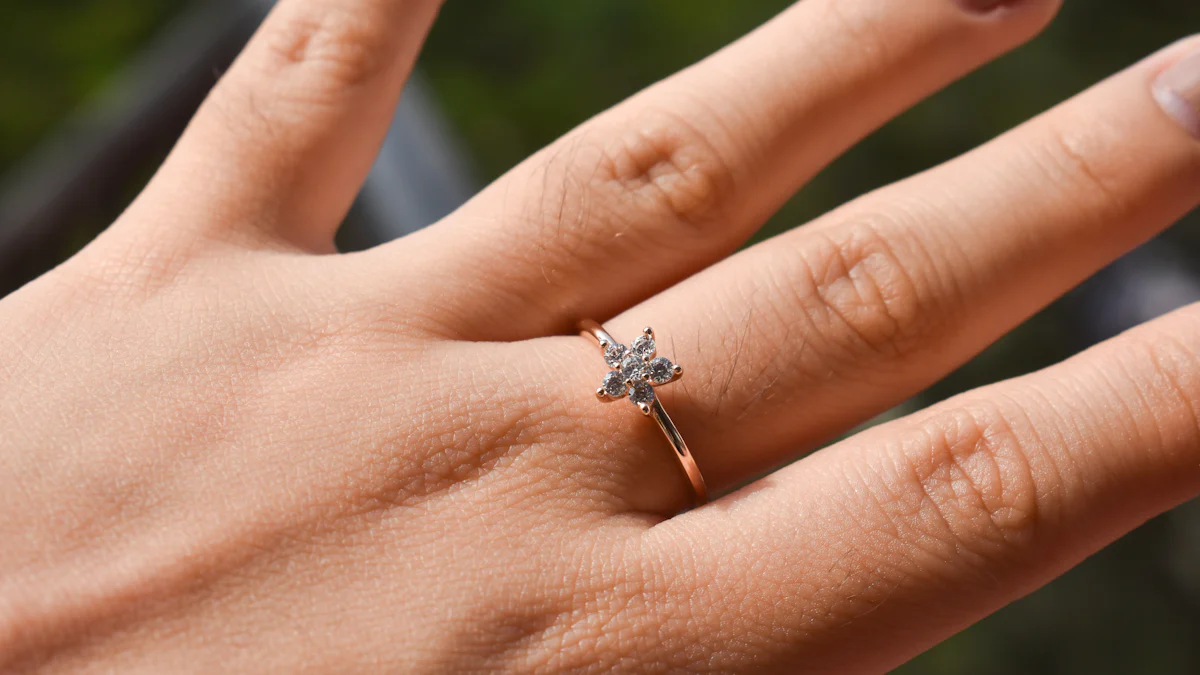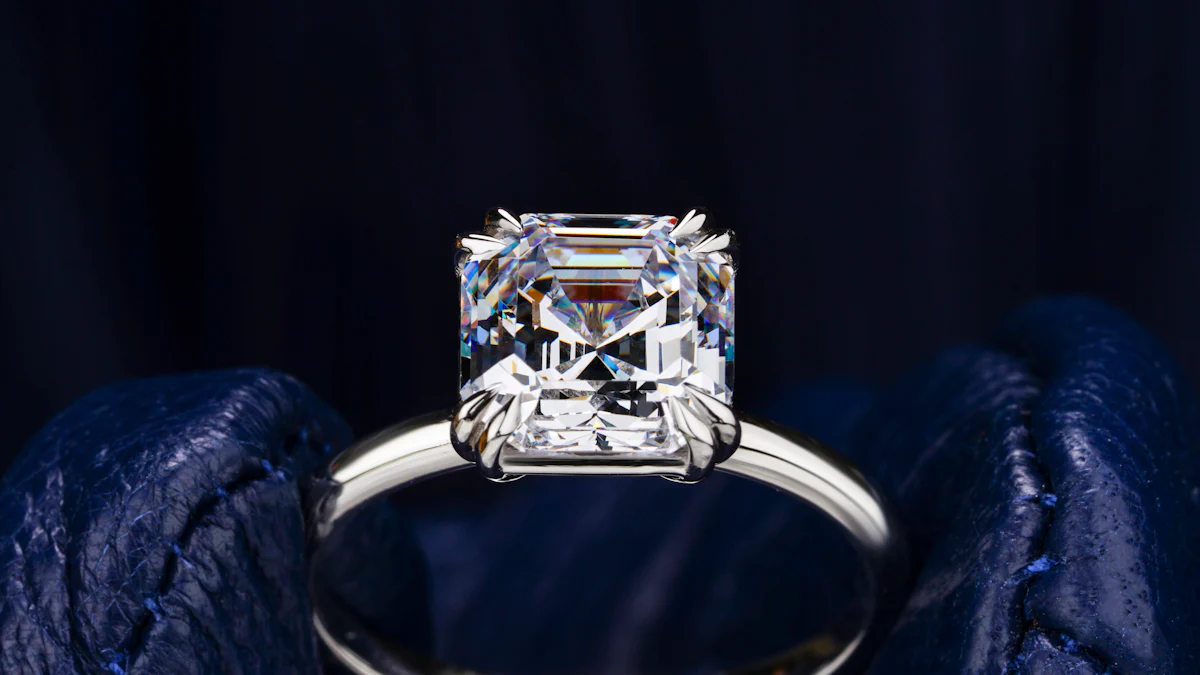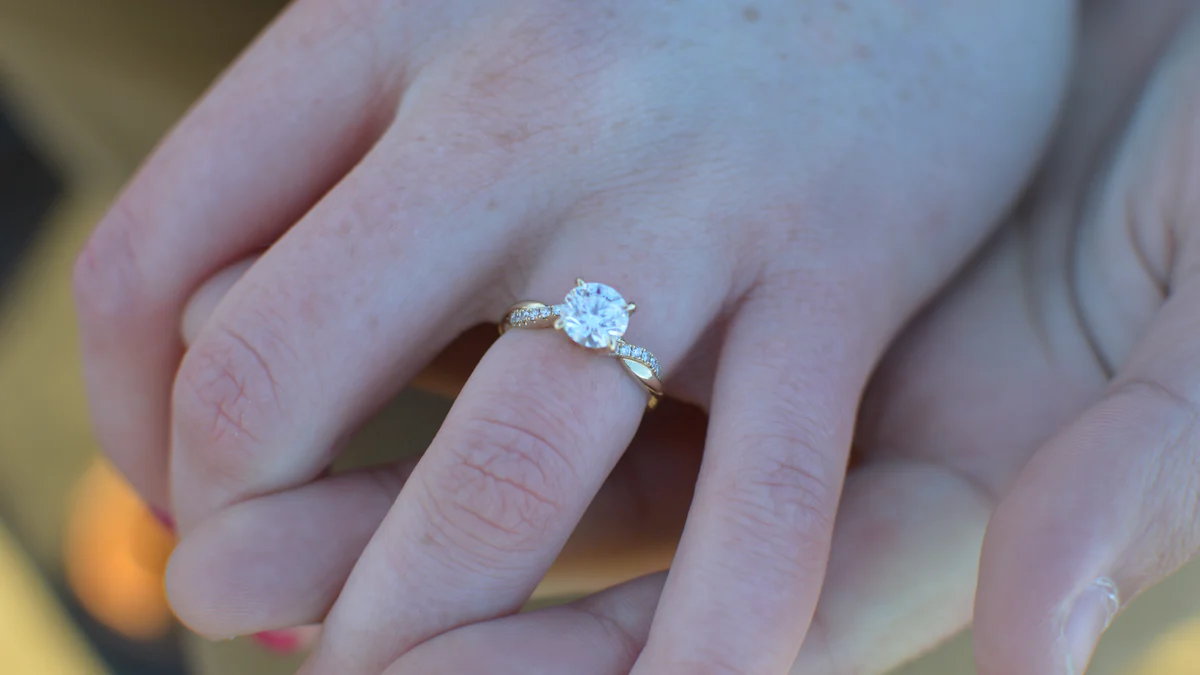How Big is 1 ct Diamond Really?

When you think about a 1 carat diamond, you might wonder, "How big is 1 ct diamond really?" A 1 carat diamond refers to its weight, not its size. Typically, a one carat diamond has a diameter of about 6.5mm. This measurement can vary slightly depending on the cut. The term "carat" represents 0.2 grams, similar to the weight of a paperclip. Understanding the actual size of a one carat diamond helps you appreciate its value and beauty. As you explore, remember that the cut and shape also influence how big a 1 ct diamond appears.
Understanding the Actual Size of a 1 Carat Diamond

When you think about the size of a diamond, you might wonder how big a 1 carat diamond really is. The term "carat" refers to the weight of the diamond, not its size. A 1 carat diamond weighs 0.2 grams, similar to the weight of a paperclip. However, the actual size can vary based on the cut and shape of the diamond.
Weight and Dimensions
A 1 carat diamond typically measures around 6.4 to 6.5 millimeters in diameter. This measurement can change slightly depending on the specific cut of the diamond. For example, a radiant-cut diamond might measure around 6.0 by 4.0 millimeters. The diamond size chart helps you understand these variations by showing the typical dimensions for different shapes and cuts.
The diamond size chart is a valuable tool when comparing diamonds. It provides a visual representation of how different cuts affect the appearance of a diamond. For instance, a round diamond might appear larger than a fancy-shaped diamond of the same carat weight due to its surface area. Understanding these dimensions helps you appreciate the true size of a 1 carat diamond.
Common Misconceptions About Size
Many people believe that a diamond's carat weight directly correlates to its size. However, this is not always the case. The diamond size chart reveals that two diamonds with the same carat weight can look different in size. This difference arises from the cut and shape of the diamond.
Another common misconception is that a larger carat weight always means a bigger diamond. While a 1 carat diamond might seem large, its actual size depends on its cut and shape. For example, a 0.8 carat diamond might appear significantly smaller than a 1 carat diamond, even though the difference in weight is minimal.
Understanding these misconceptions helps you make informed decisions when choosing a diamond. By considering both the carat weight and the dimensions, you can select a diamond that meets your expectations in terms of size and appearance.
How Big is a 1 Carat Diamond: The Influence of Cut
When considering how big a 1 carat diamond appears, the cut plays a crucial role. The cut of a diamond doesn't just refer to its shape but also its proportions, symmetry, and polish. These factors significantly impact the diamond's brilliance and perceived size. A well-cut diamond reflects light beautifully, making it appear larger and more dazzling. Conversely, a poorly cut diamond may look smaller and less vibrant, even if it weighs 1 carat.
How Different Cuts Affect Appearance
Different diamond cuts can dramatically alter the appearance of a 1 carat diamond. For instance, a round brilliant cut maximizes sparkle and often appears larger due to its symmetrical shape and excellent light reflection. On the other hand, a princess cut, with its sharp corners and square shape, might seem slightly smaller because of its angular design.
The emerald cut, known for its rectangular shape, can elongate the diamond, giving the illusion of a larger stone. This cut emphasizes clarity over brilliance, offering a unique and sophisticated look. Each cut has its own charm and can influence how big a 1 carat diamond looks to the naked eye.
Popular Cuts and Their Visual Impact
Several popular cuts can enhance the visual impact of a 1 carat diamond. The round brilliant cut remains a favorite due to its ability to maximize sparkle and create an impression of size. The princess cut, with its modern and edgy look, appeals to those who prefer a contemporary style. Despite its angular design, it can still offer a striking appearance.
The cushion cut, with its rounded corners and larger facets, provides a vintage charm and can make a 1 carat diamond appear larger. The oval cut, similar to the round cut in brilliance, offers an elongated shape that enhances the diamond's perceived size. Each of these cuts brings out different aspects of a diamond's beauty, influencing how big a 1 carat diamond seems.
Choosing the right cut involves considering personal style and how you want the diamond to appear. A well-cut diamond, regardless of its carat weight, will always stand out and capture attention.
One Carat Diamond: The Role of Shape in Appearance

Round vs. Fancy Shapes
When you explore diamond shapes, you encounter two main categories: round and fancy shapes. Each shape offers a unique visual experience. The round brilliant cut remains the most popular choice. Its symmetrical design maximizes sparkle and often appears larger than its actual size. This shape reflects light efficiently, enhancing its brilliance.
Fancy shapes, such as princess, emerald, and oval, provide distinct aesthetics. The princess cut, with its square form, offers a modern look. It may appear slightly smaller due to its angular corners. The emerald cut, known for its rectangular shape, emphasizes clarity over sparkle. It creates an elongated appearance, making the diamond seem larger. Oval shapes, similar to round cuts, enhance perceived size with their elongated form.
How Shape Affects Light Reflection
The shape of a diamond significantly influences how it interacts with light. Diamond Cut Proportions and Light Reflection studies reveal that cut proportions directly affect a diamond's ability to reflect light. The angles and proportions of each facet determine the diamond's brilliance and sparkle.
A well-cut diamond, regardless of shape, will reflect light beautifully. This reflection creates brightness, fire, and scintillation, contributing to the diamond's overall appeal. For instance, round diamonds excel in light reflection due to their symmetrical facets. They maximize sparkle, making them appear larger and more dazzling.
Fancy shapes, while unique, may reflect light differently. The princess cut, with its sharp angles, can create a striking appearance but may not match the round cut's brilliance. The emerald cut, with its step-cut facets, emphasizes clarity and offers a sophisticated look. Each shape interacts with light uniquely, affecting how big a 1 carat diamond appears to you.
Understanding these aspects helps you appreciate the role of shape in a diamond's appearance. By considering both shape and cut quality, you can select a diamond that meets your expectations in terms of size and brilliance.
Factors Affecting the Appearance of a 1 Carat Diamond
Depth and Spread
When you evaluate a 1 carat diamond, depth and spread play crucial roles in its appearance. Depth refers to the distance from the diamond's table to its culet, while spread describes how large the diamond appears when viewed from above. A diamond with an ideal depth reflects light beautifully, enhancing its brilliance and fire. If the depth is too shallow, the diamond might appear larger but could lack sparkle. Conversely, a deep cut can make the diamond look smaller and less vibrant.
To achieve the best visual appeal, consider the diamond's spread. A well-spread diamond maximizes its surface area, making it look larger for its carat weight. This aspect becomes particularly important when you want a diamond that appears substantial without increasing the carat weight. By understanding these factors, you can select a diamond that balances size and brilliance effectively.
The Importance of Proportions
Proportions significantly influence a diamond's overall appearance. They determine how light travels through the diamond, affecting its sparkle and perceived size. Ideal proportions ensure that the diamond reflects light optimally, creating a dazzling effect. When you choose a diamond, pay attention to the table size, crown height, and pavilion depth. These elements work together to enhance the diamond's beauty.
A diamond with excellent proportions will exhibit superior light performance. It will appear bright and lively, capturing attention with its brilliance. Poor proportions, on the other hand, can result in a dull appearance, even if the diamond has a high carat weight. By focusing on proportions, you ensure that your diamond not only looks larger but also shines brilliantly.
Understanding depth, spread, and proportions helps you make informed decisions when selecting a 1 carat diamond. These factors contribute to the diamond's visual appeal, ensuring that it meets your expectations in terms of size and sparkle.
Tips for Choosing the Right One Carat Diamond Ring
When selecting a 1 carat diamond ring, you want to ensure it meets your expectations in terms of appearance and value. Here are some tips to guide you in making an informed choice.
Enhancing Visual Size
To make a 1 carat diamond ring appear larger, focus on its cut quality. A well-cut diamond reflects light beautifully, maximizing its brilliance and perceived size. Opt for cuts like the round brilliant or oval, which enhance the diamond's sparkle and make it look more substantial. Consider the setting style as well. A halo setting, where smaller diamonds encircle the center stone, can create the illusion of a larger diamond.
Additionally, choose a band that complements the diamond without overpowering it. A thinner band can make the diamond stand out more prominently. By paying attention to these details, you can enhance the visual size of your one carat diamond ring.
Balancing Cut, Color, and Clarity
When choosing a one carat diamond engagement ring, balance is key. The cut, color, and clarity of the diamond significantly impact its overall appearance and value. Prioritize cut quality, as it influences how the diamond interacts with light. A well-cut diamond will always appear more brilliant and attractive.
Color and clarity also play crucial roles. Aim for a diamond with a color grade that appears white to the naked eye. For clarity, select a diamond with minimal inclusions that do not affect its beauty. By balancing these factors, you ensure that your 1 carat diamond ring not only looks stunning but also holds its value over time.
Understanding these aspects helps you choose a diamond that aligns with your preferences and budget. Whether you're selecting a one carat diamond ring for yourself or a loved one, these tips will guide you in making a choice that brings joy and satisfaction.
Making an Informed Purchase of a 1 Carat Diamond
When you're ready to buy a 1 carat diamond, making informed decisions ensures you get the best value and quality. Here are some essential steps to guide you through the process.
Setting a Budget
Setting a budget is the first step in purchasing a diamond. You need to determine how much you're willing to spend. This helps narrow down your options and prevents overspending. Many people prefer a 1 carat natural diamond for its classic appeal. However, others might choose a 2-carat lab-grown diamond for its size and ethical sourcing.
Survey Results:
- 55% of respondents prefer a 1-carat natural diamond.
- 45% lean towards a 2-carat lab-grown diamond.
Consider what matters most to you. Is it the size, the origin, or the environmental impact? Your budget should reflect these priorities. Remember, a well-planned budget allows you to explore various options without financial strain.
Consulting with Experts
Consulting with experts can provide valuable insights into your diamond purchase. Jewelers and gemologists offer guidance on selecting the right diamond based on your preferences and budget. They can explain the nuances of cut, color, clarity, and carat weight. This knowledge helps you make a choice that aligns with your expectations.
"Majority of respondents think sustainability and ethical sourcing are important when making an engagement ring purchase."
Experts can also inform you about sustainable and ethically sourced diamonds. This information is crucial if you value environmental responsibility. By seeking expert advice, you gain confidence in your purchase decision.
You now understand that a 1 carat diamond's size and appearance depend on various factors. The shape, cut proportions, clarity, and color all play crucial roles in how large and brilliant the diamond appears. Remember, carat weight doesn't solely determine size. Visual appearance is influenced by the diamond's characteristics and even your finger size. Consider these aspects when choosing a diamond. Explore further to find the perfect diamond that meets your expectations. Whether you're buying for yourself or a loved one, make an informed decision that brings lasting joy.
FAQ
What is a Carat?
A carat measures the weight of a diamond, not its size. One carat equals 0.2 grams, similar to the weight of a paperclip. This unit helps you understand the diamond's weight, but remember that size can vary based on cut and shape.
How Big is a 1 Carat Diamond?
A 1 carat diamond typically measures around 6.4 to 6.5 millimeters in diameter. However, the actual size can differ depending on the diamond's cut and shape. For example, a round diamond might appear larger than a fancy-shaped diamond of the same carat weight.
Does a 1-Carat Diamond Always Look the Same Size?
No, a 1-carat diamond does not always look the same size. The cut, shape, and proportions influence its appearance. A well-cut diamond reflects light better, making it appear larger and more brilliant.
How Can I Get the Best Value in a 1 Carat Diamond?
To get the best value, consult a diamond expert. They can help you review diamonds and find high-quality 1 carat diamond rings. Their expertise ensures you make an informed decision.
What Qualities Get Me the Best Value for a 1 Carat Diamond Ring?
For a 1 carat diamond, aim for a minimum of an SI1 grade. This grade ensures most inclusions and blemishes remain invisible to the naked eye. You might find an SI1 with inclusions near the edges, which the setting prongs can cover.
What is the Best Setting for a 1-Carat Diamond?
The best setting depends on personal preference. A halo setting can make the diamond appear larger by surrounding it with smaller stones. A solitaire setting highlights the diamond's beauty and simplicity.
How Does the Diamond Sizing Guide Help?
A diamond sizing guide provides a visual representation of how different cuts affect a diamond's appearance. It helps you compare sizes and understand how various shapes and cuts influence the perceived size of a 1 carat diamond.
See Also
Exploring The Size Of A 2.25 Carat Diamond
Are 1.6 Carat Diamond Rings Really Worth It?
What Is The Price Of A 2 Carat Lab Diamond?

